-
 Bitcoin
Bitcoin $107,631.9817
-1.73% -
 Ethereum
Ethereum $2,739.1787
-4.61% -
 Tether USDt
Tether USDt $1.0000
-0.01% -
 XRP
XRP $2.2427
-3.30% -
 BNB
BNB $664.0527
-0.73% -
 Solana
Solana $158.0902
-5.38% -
 USDC
USDC $0.9998
-0.01% -
 Dogecoin
Dogecoin $0.1876
-7.78% -
 TRON
TRON $0.2753
-3.21% -
 Cardano
Cardano $0.6820
-5.55% -
 Hyperliquid
Hyperliquid $43.0171
-0.38% -
 Sui
Sui $3.3308
-4.87% -
 Chainlink
Chainlink $14.3431
-7.89% -
 Avalanche
Avalanche $21.0266
-6.48% -
 Bitcoin Cash
Bitcoin Cash $437.7657
-1.56% -
 Stellar
Stellar $0.2746
-2.52% -
 UNUS SED LEO
UNUS SED LEO $8.8665
-1.96% -
 Toncoin
Toncoin $3.1885
-3.37% -
 Shiba Inu
Shiba Inu $0.0...01260
-6.84% -
 Hedera
Hedera $0.1686
-4.93% -
 Litecoin
Litecoin $88.8406
-5.16% -
 Polkadot
Polkadot $4.0542
-6.28% -
 Monero
Monero $322.5806
-4.20% -
 Ethena USDe
Ethena USDe $1.0004
-0.02% -
 Bitget Token
Bitget Token $4.7089
-3.10% -
 Dai
Dai $0.9998
-0.01% -
 Pepe
Pepe $0.0...01206
-9.06% -
 Uniswap
Uniswap $7.8694
-5.20% -
 Pi
Pi $0.6232
-2.68% -
 Aave
Aave $301.3815
-3.83%
What should I do if the MACD weekly line golden cross and monthly line dead cross? How to weigh decisions when multiple cycles conflict?
When weekly MACD shows a golden cross but monthly shows a dead cross, assess market context, signal strength, and use additional indicators to make informed trading decisions.
Jun 11, 2025 at 07:00 pm
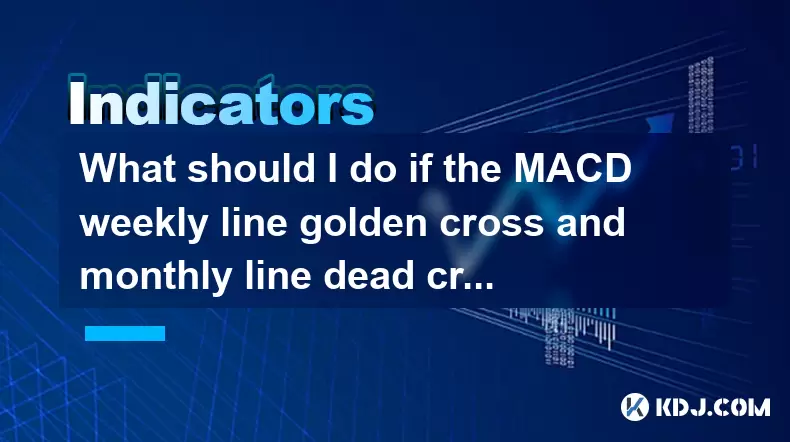
When dealing with conflicting signals from different timeframes in technical analysis, such as a weekly MACD golden cross and a monthly MACD dead cross, it's crucial to understand the implications and weigh the potential outcomes carefully. This article will delve into how to interpret these signals, the importance of different timeframes, and strategies to make informed decisions when such conflicts arise.
Understanding MACD and Its Signals
The Moving Average Convergence Divergence (MACD) is a trend-following momentum indicator that shows the relationship between two moving averages of a security's price. It consists of the MACD line, the signal line, and the histogram. A golden cross occurs when the MACD line crosses above the signal line, indicating a bullish signal. Conversely, a dead cross happens when the MACD line crosses below the signal line, signaling a bearish trend.
Interpreting Weekly and Monthly Signals
A weekly MACD golden cross suggests that the short-term trend is turning bullish. This signal is significant for traders focusing on medium-term positions, as it indicates potential upward momentum in the coming weeks. On the other hand, a monthly MACD dead cross indicates a bearish trend over a longer period, suggesting that the overall market sentiment may be shifting downwards.
The Importance of Timeframes in Decision Making
When dealing with conflicting signals from different timeframes, it's essential to consider the weight of each timeframe on your trading strategy. Shorter timeframes, like weekly charts, are more sensitive to recent price changes and can provide early signals of trend changes. However, they are also more prone to false signals. Longer timeframes, such as monthly charts, tend to be more reliable but slower to react to new trends.
Strategies for Weighing Conflicting Signals
When faced with a weekly MACD golden cross and a monthly MACD dead cross, consider the following strategies to make an informed decision:
Assess Market Context: Look at the broader market conditions. If the overall market is in a bullish phase, the weekly golden cross might carry more weight. Conversely, if the market is bearish, the monthly dead cross could be more significant.
Evaluate the Strength of Signals: Compare the strength of the signals. A strong weekly golden cross, with a significant distance between the MACD line and the signal line, might suggest a more robust short-term bullish trend than a weak monthly dead cross.
Consider Additional Indicators: Use other technical indicators, such as the Relative Strength Index (RSI) or Bollinger Bands, to confirm or refute the signals provided by the MACD. If multiple indicators support the weekly golden cross, it might be more reliable.
Review Historical Data: Analyze past instances where similar conflicts occurred. How did the market react? Did the shorter or longer timeframe signal prove more accurate?
Adjust Position Sizing: If you decide to trade based on the conflicting signals, consider adjusting your position size to manage risk. A smaller position can help mitigate potential losses if the market moves against your decision.
Practical Example: Analyzing a Cryptocurrency
Let's consider a practical example using Bitcoin (BTC) to illustrate how to apply these strategies:
Weekly Chart Analysis: On the weekly chart, you notice a MACD golden cross. The MACD line has crossed above the signal line, and the histogram is showing increasing positive values. This suggests a potential bullish trend in the short term.
Monthly Chart Analysis: On the monthly chart, you see a MACD dead cross. The MACD line has crossed below the signal line, and the histogram is showing increasing negative values. This indicates a bearish trend over the longer term.
Market Context: You check the broader market sentiment and find that the overall crypto market is in a consolidation phase, with no clear bullish or bearish trend dominating.
Strength of Signals: The weekly golden cross shows a strong divergence between the MACD line and the signal line, indicating a robust short-term bullish signal. The monthly dead cross, however, shows a weaker divergence, suggesting a less convincing long-term bearish signal.
Additional Indicators: You consult the RSI on both timeframes. The weekly RSI is rising and approaching overbought levels, supporting the bullish signal. The monthly RSI is neutral, not confirming the bearish signal strongly.
Historical Data: You review past instances of conflicting weekly and monthly MACD signals for Bitcoin. Historically, the weekly signals have been more reliable during consolidation phases.
Decision Making: Based on this analysis, you might decide to take a bullish position on Bitcoin, focusing on the weekly golden cross. However, to manage risk, you could opt for a smaller position size due to the conflicting monthly dead cross.
Implementing the Decision
If you decide to trade based on the weekly golden cross, here are the steps to implement your decision:
Select a Trading Platform: Choose a reliable cryptocurrency exchange that supports Bitcoin trading, such as Binance or Coinbase.
Fund Your Account: Deposit the necessary funds into your trading account, ensuring you have enough to cover your intended position size.
Set Up the Trade:
- Navigate to the Bitcoin trading pair (e.g., BTC/USDT).
- Enter the amount you want to buy, considering your position sizing strategy.
- Set your entry price based on the current market rate or a limit order if you want to enter at a specific price.
- Set stop-loss and take-profit levels to manage risk and lock in potential gains.
Monitor and Adjust: Keep an eye on the market and adjust your stop-loss and take-profit levels as needed. If the market moves against your position, consider whether to hold or exit based on new developments.
Frequently Asked Questions
Q1: Can I use other technical indicators to resolve conflicts between weekly and monthly MACD signals?
A1: Yes, other technical indicators like the RSI, Bollinger Bands, and Fibonacci retracement levels can provide additional insights. If these indicators align more closely with one of the MACD signals, it can help you make a more informed decision.
Q2: How important is the volume when analyzing MACD signals?
A2: Volume is a crucial factor in confirming MACD signals. An increase in volume accompanying a MACD golden cross can validate the bullish signal, while a decrease in volume during a dead cross can strengthen the bearish indication.
Q3: Should I always prioritize longer-term signals over shorter-term signals?
A3: Not necessarily. The priority depends on your trading strategy and risk tolerance. If you are a long-term investor, monthly signals might be more relevant. However, if you are a swing trader, weekly signals could be more useful. Always consider the context and strength of the signals.
Q4: How can I minimize the risk when trading based on conflicting signals?
A4: To minimize risk, consider using smaller position sizes, setting tight stop-loss orders, and diversifying your portfolio. Additionally, continuous monitoring and adjusting your strategy based on new market information can help manage risk effectively.
Disclaimer:info@kdj.com
The information provided is not trading advice. kdj.com does not assume any responsibility for any investments made based on the information provided in this article. Cryptocurrencies are highly volatile and it is highly recommended that you invest with caution after thorough research!
If you believe that the content used on this website infringes your copyright, please contact us immediately (info@kdj.com) and we will delete it promptly.
- Expert Predicts When Bitcoin (BTC) Price Could Hit a New All-Time High
- 2025-06-13 02:00:20
- US President Donald Trump Virtually Spoke at the Coinbase State of Crypto Summit
- 2025-06-13 02:00:20
- Arctic Pablo Coin (APC) Explodes Onto the Meme Coin Stage as One of the Top New Meme Coins for Exponential Returns
- 2025-06-13 01:55:12
- Litecoin (LTC) Price Nosedives as Bollinger Bands Signal Lingering Bearish Sentiment
- 2025-06-13 01:55:12
- DeFi Development Corp. (DFDV) Secures $5 Billion Equity Line of Credit from RK Capital Management
- 2025-06-13 01:50:12
- Tether Expands Gold Strategy with Stake in Elemental Altus Royalties
- 2025-06-13 01:50:12
Related knowledge
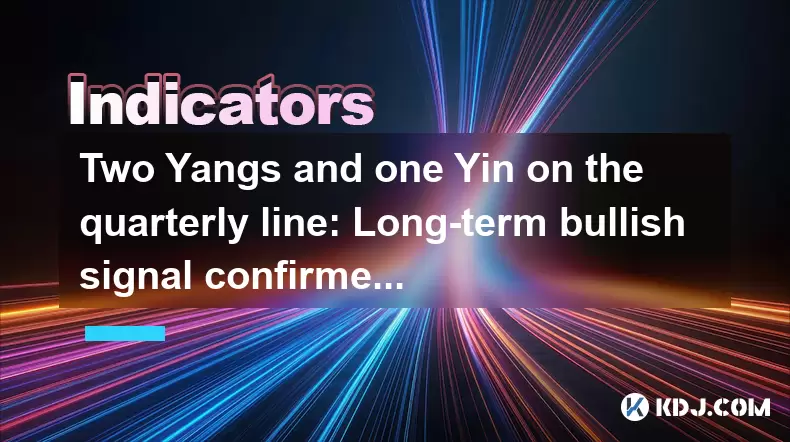
Two Yangs and one Yin on the quarterly line: Long-term bullish signal confirmed?
Jun 12,2025 at 07:00am
Understanding the 'Two Yangs and One Yin' Candlestick PatternIn technical analysis, candlestick patterns play a pivotal role in identifying potential market reversals or continuations. The 'Two Yangs and One Yin' pattern is one such formation that traders often observe on longer timeframes like the quarterly chart. This pattern consists of two bullish (...
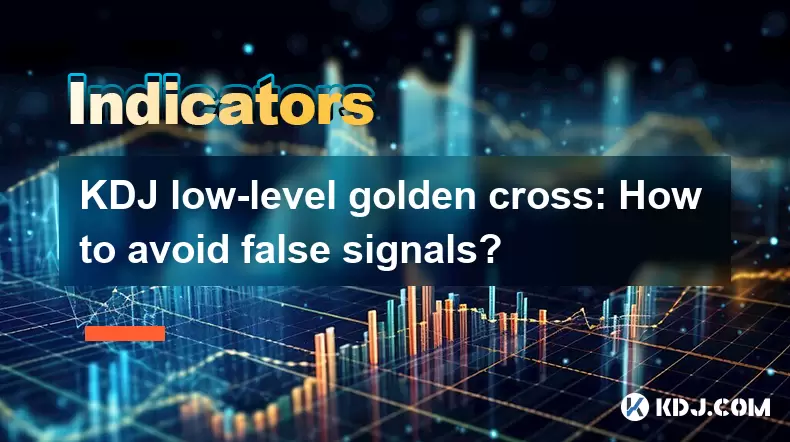
KDJ low-level golden cross: How to avoid false signals?
Jun 12,2025 at 08:21am
Understanding the KDJ IndicatorThe KDJ indicator, also known as the stochastic oscillator, is a momentum-based technical analysis tool widely used in cryptocurrency trading. It consists of three lines: the %K line (fast stochastic), the %D line (slow stochastic), and the %J line (divergence value). These lines oscillate between 0 and 100, helping trader...

Bottom-up volume stagnation: Is it accumulation or heavy selling pressure?
Jun 12,2025 at 01:42pm
What Is Bottom-Up Volume Stagnation?Bottom-up volume stagnation refers to a specific pattern observed in cryptocurrency trading charts where the price of an asset moves sideways or slightly downward, and trading volume remains consistently low over an extended period. This phenomenon is often seen after a sharp price drop or during a prolonged bear mark...
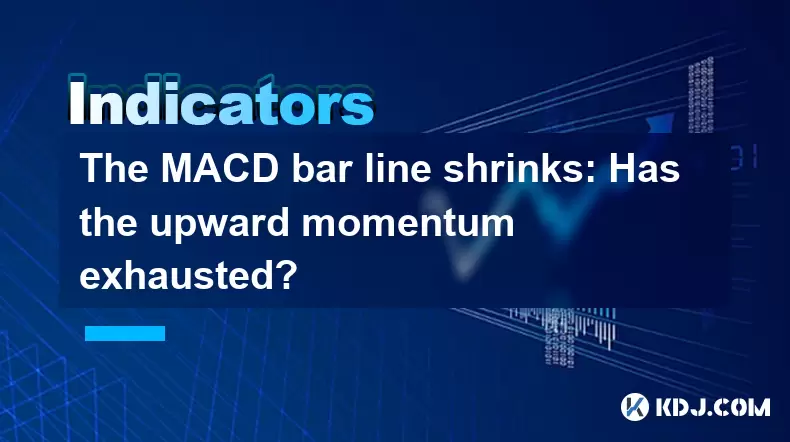
The MACD bar line shrinks: Has the upward momentum exhausted?
Jun 12,2025 at 12:49am
Understanding the MACD Bar LineThe Moving Average Convergence Divergence (MACD) is a widely used technical indicator in cryptocurrency trading. It consists of three main components: the MACD line, the signal line, and the MACD histogram (also known as the bar line). The MACD bar line represents the difference between the MACD line and the signal line. W...

The chip peak moves up: Is the main force quietly shipping?
Jun 12,2025 at 01:01am
Understanding the Chip Peak Movement in Cryptocurrency MiningIn recent years, the chip peak movement has become a critical topic within the cryptocurrency mining community. This phrase typically refers to the point at which mining hardware reaches its maximum efficiency and output capacity. When this peak shifts upward, it often signals changes in the s...
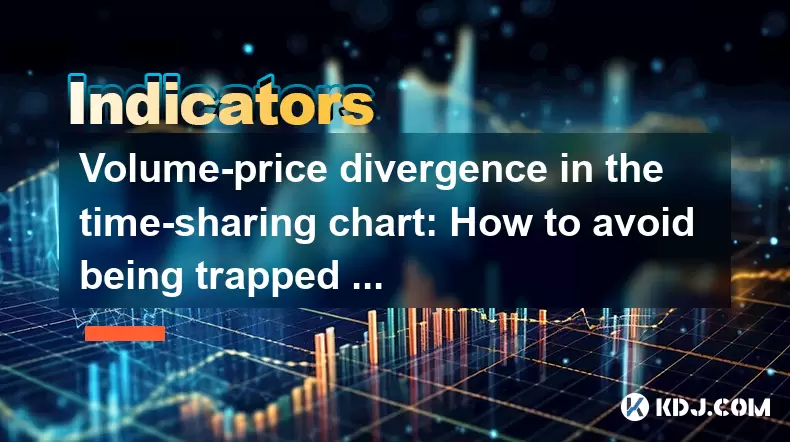
Volume-price divergence in the time-sharing chart: How to avoid being trapped on the same day?
Jun 12,2025 at 07:28pm
Understanding Volume-Price Divergence in Cryptocurrency TradingVolume-price divergence is a critical concept in technical analysis, especially within the fast-moving world of cryptocurrency trading. It refers to a situation where price movement and trading volume move in opposite directions. For instance, if the price of a cryptocurrency is rising while...

Two Yangs and one Yin on the quarterly line: Long-term bullish signal confirmed?
Jun 12,2025 at 07:00am
Understanding the 'Two Yangs and One Yin' Candlestick PatternIn technical analysis, candlestick patterns play a pivotal role in identifying potential market reversals or continuations. The 'Two Yangs and One Yin' pattern is one such formation that traders often observe on longer timeframes like the quarterly chart. This pattern consists of two bullish (...

KDJ low-level golden cross: How to avoid false signals?
Jun 12,2025 at 08:21am
Understanding the KDJ IndicatorThe KDJ indicator, also known as the stochastic oscillator, is a momentum-based technical analysis tool widely used in cryptocurrency trading. It consists of three lines: the %K line (fast stochastic), the %D line (slow stochastic), and the %J line (divergence value). These lines oscillate between 0 and 100, helping trader...

Bottom-up volume stagnation: Is it accumulation or heavy selling pressure?
Jun 12,2025 at 01:42pm
What Is Bottom-Up Volume Stagnation?Bottom-up volume stagnation refers to a specific pattern observed in cryptocurrency trading charts where the price of an asset moves sideways or slightly downward, and trading volume remains consistently low over an extended period. This phenomenon is often seen after a sharp price drop or during a prolonged bear mark...

The MACD bar line shrinks: Has the upward momentum exhausted?
Jun 12,2025 at 12:49am
Understanding the MACD Bar LineThe Moving Average Convergence Divergence (MACD) is a widely used technical indicator in cryptocurrency trading. It consists of three main components: the MACD line, the signal line, and the MACD histogram (also known as the bar line). The MACD bar line represents the difference between the MACD line and the signal line. W...

The chip peak moves up: Is the main force quietly shipping?
Jun 12,2025 at 01:01am
Understanding the Chip Peak Movement in Cryptocurrency MiningIn recent years, the chip peak movement has become a critical topic within the cryptocurrency mining community. This phrase typically refers to the point at which mining hardware reaches its maximum efficiency and output capacity. When this peak shifts upward, it often signals changes in the s...

Volume-price divergence in the time-sharing chart: How to avoid being trapped on the same day?
Jun 12,2025 at 07:28pm
Understanding Volume-Price Divergence in Cryptocurrency TradingVolume-price divergence is a critical concept in technical analysis, especially within the fast-moving world of cryptocurrency trading. It refers to a situation where price movement and trading volume move in opposite directions. For instance, if the price of a cryptocurrency is rising while...
See all articles

























































































